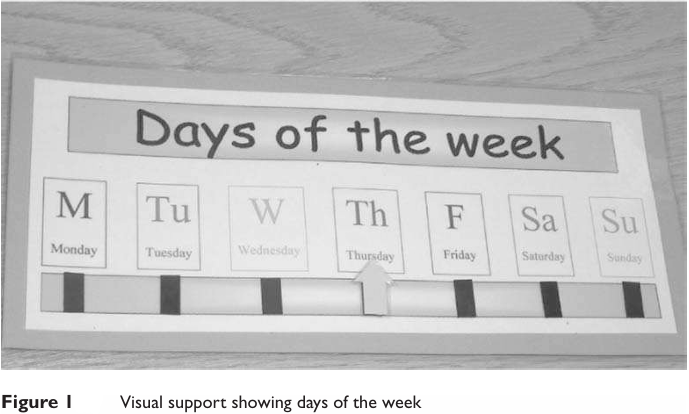


 Grammar
Grammar
 Tenses
Tenses
 Present
Present
 Past
Past
 Future
Future
 Parts Of Speech
Parts Of Speech
 Nouns
Nouns
 Verbs
Verbs
 Adverbs
Adverbs
 Adjectives
Adjectives
 Pronouns
Pronouns
 Pre Position
Pre Position
 Preposition by function
Preposition by function 
 Preposition by construction
Preposition by construction
 Conjunctions
Conjunctions
 Interjections
Interjections
 Grammar Rules
Grammar Rules
 Linguistics
Linguistics
 Semantics
Semantics
 Pragmatics
Pragmatics
 Reading Comprehension
Reading Comprehension
 Teaching Methods
Teaching Methods|
Read More
Date: 2025-04-15
Date: 2025-04-09
Date: 2025-04-30
|
Visual learning
Learners with ASD tend to be highly visual learners and like structure. Classroom organization can support pupils to work more independently. Figures 10.1–10.3 show visual supports produced to support the inclusion and dependent working of pupils with autistic spectrum disorders who may have difficulty understanding verbal instructions, especially when they are long and refer to routines they have not been taught explicitly, e.g. getting ready for PE. These supports can be just text if the pupil can read but they are often supported by symbols from the Rebus or Mayer Johnson sets and can be produced using word processing, desktop publishing or dedicated software such as Writing With Symbols from www.widgit.co.uk
Figure 1 is visual support showing the days of the week for a learner. This might be a resource for the whole class, which then has a display of what happens on a particular day. In a secondary school context this information may well be part of the learner’s planner with the teaching assistant role being to ensure at the beginning of the day that the learner knows what day it is, where they need to be and what equipment they need. At the end of the day, the TA may want to check that the learner is clear about what homework is needed.

Figure 1 in Structure shows symbol-supported timetables that indicate what is happening during different parts of the day. These may be the instructions for carrying out an activity in class.
Figure 2 in Structure is an equipment prompt that has removable symbols according to the equipment requirements of a task. For older learners, the use of diagrams, charts, worksheets with pictures, spider diagrams and mind maps, videos, overhead transparencies and videos can help to make abstract concepts more concrete. As learners with ASD tend to focus on the detail rather than the big picture, it is helpful if you do have a big picture that shows the concepts being taught. Further guidance of visual strategies to improve communication can be found in Linda Hodgon’s (1996) well regarded book.
Visual supports can also include written words and sentences. The key point is that instructions that are spoken are transitory. They are here one moment and gone the next. When verbal instructions are given, try to give them in a simple form and speak slowly, allowing time for the child to process the information.
|
|
|
|
مقاومة الأنسولين.. أعراض خفية ومضاعفات خطيرة
|
|
|
|
|
|
|
أمل جديد في علاج ألزهايمر.. اكتشاف إنزيم جديد يساهم في التدهور المعرفي ؟
|
|
|
|
|
|
|
العتبة العباسية المقدسة تنظّم دورةً حول آليّات الذكاء الاصطناعي لملاكاتها
|
|
|